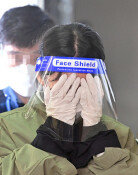Provisional gov't is lined to domestic organization in Shanghai
Provisional gov't is lined to domestic organization in Shanghai
Posted May. 05, 2018 07:55,
Updated May. 05, 2018 07:55
Chung-ang School, located at #1, Gye-dong, Northern Village of Gyeongseong (Seoul), is a two-story high building made of red bricks built on a mountain slope of Samcheong-dong amidst the lush green. The School became a famous site of Jangan. Completed in November 1917, it was a new school built solely on the capital of the nation, and the passion and effort of Koreans, where teachers and students prepared the land and carried stones themselves. (from the Dec. 4, 1917 issue of the Korea Daily News).
Kim Sung-soo (1891-1955), founder of the school, chose the land himself. It was a perfect location with the spirit of Mt. Bukak in the back and capital of Gyeongseong in the front, along with Kim’s commitment to develop the vast spirit of students.
Like a birthplace of independence education and national rehabilitation, Chung-ang School was a training school that generated nationalists as well as the very source of fostering independence commitment of anti-Japan. Kim Won-bong, the head of the heroic group who appalled Japanese with terrorisms against them, Kim Doo-bong, who established the Korean Volunteer Corp., Lee Sang-hwa, a famous national poet who wrote the poem “Will there be Spring in the Stolen Hill?,” and many more independence activists were all alumnus of Chung-ang School.
In January 1919, the campus of Chung-ang School, which became a famous sight of the Northern Village amid the cold wintry wind, became hot with a delicate heat. Ever since Song Gye-baek, an international student from Tokyo, came to Chung-ang School with the draft version of the February Eighth Independence Declaration, the School transformed into a headquarter of operation to discuss the March 1st Independence Movement.
The night-duty-room (used as a house for the school principal back then), located at the south-eastern part of the schoolyard in front of classrooms, would be lighted up until late at night. Founder Kim Sung-soo, Principal Go Ha, and teacher Hyeon Sang-yoon (1893~?) lived together and mapped out the future of the country. Patriots from outside who came to visit would actively yet secretly discuss the independence movement with the teams of Chung-ang School while students watched out for the tail of secrete agents of Japan.
Kim Sung-soo and Go ha would have meals at Kim Sa-yong’s house (#130, Gyeo-dong), which was nearby. It is no surprise that Kim Sung-soo’s residence became a gathering place for independence movement under the pretense of a meal. International students and domestic patriots would visit Chung-ang School and Kim Sung soo’s residence. It was Kim Sung-soo’s residence that Yeo Wun-hong (younger brother of Yeo Wun-hyung), who carried out activities in the United States, visited when he sneaked into Korea after receiving a secret order to bring “one million signatures for independence petition” to be submitted at the Paris Peace Conference. Yeo Wun-hong also graduated Chung-ang School,
As such, the Northern Village became the place that connected Korea and abroad. The problem began here. The problem being, in what way would mass independence movement be held within Korea. The team of Chung-ang School, comprised of Kim Sung-soo, Song Jin-woo and Hyeon Sang-yun. believed that domestic independence in its nature, cannot be successful with the power of just a couple of sects or organizations. As a result, they determined that domestic independence movement can only be the most effective and ideal when the major power of the people engages in a revolution altogether and receive support from abroad. (from an autobiography of Song Jin-woo).
They first decided to reach out to Cheondogyo. They used the February 8th Declaration of Independence (draft), that was brought in by Song Gye-baek as a “weapon” for persuasion. Hyeon Sang-yoon visited Choi Lin (1878~1958) with Song Gye-baek. Choi Lin, who was the principal of an educational institution under Cheondogyo called Bosung School, was also the teacher of Hyeon Sang-yoon and Song Gye-baek when they attended Bosung School.
Choi Lin was startled when he saw the independence declaration from Song Gye-baek and immediately reported it to the leader of Cheondogyo, Son Byung-hee (1861~1922). Son Byung-hee was planning a revolution earlier through the information network and concerted organizational power of Cheondo National Salvation Group led by Lee Jong-il. After gaining access to the declaration, Son Byeong-hee was determined to engage in a national revolution in solidarity with powers within Korea and abroad.
Song Jin-woo and Hyun Sang-yoon, who confirmed Son’s participation, gathered at a sanctum in Choi Lin’s house to held a secret meeting, and also celebrated the finalized decision. Choi Lin, who represented the opinion of Son Byung-hee, participated at the revolution for independence movement as a main player along with the teams of Chung-ang School.
Coincidently, Choi Lin and Son Byung-hee also resided in the Northern Village. Choi Lin lived at # 68 Jae-dong (now the site for Constitutional Court) and Son Byung-hee lived at #170, Gahoe-dong (now the site for Northern Village Museum). Yusimsa (#43, Gye-dong), which was operated by Han Yong-un, who was one of the 33 Korean leaders, lived in the Northern Village as well. In one way or another, the Northern Village, which used to be a place where ruling class of aristocrats lived since the Joseon Dynasty, became the frontline for the March 1st Independence Movement.
ojong@donga.com







